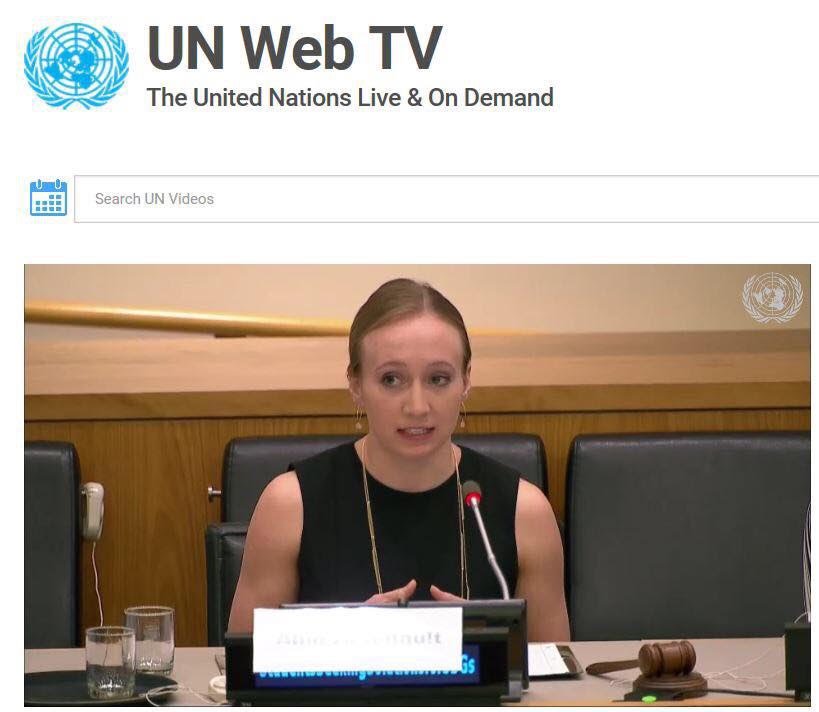Student reflection: Presenting wastewater treatment research at UN headquarters

CSE undergrad invited to speak at inaugural global conference in New York City
Allie Arsenault was one of seven undergraduate students nationwide selected to present their research and solution to the clean water crisis at an April 2018 conference in the United Nations building. Arsenault is majoring in bioproducts and biosystems engineering at the University of Minnesota's College of Science and Engineering, with minors in chemistry and Spanish.
May 23, 2018
In the fall of 2017, I began working with graduate student Carlise Sorenson on her graduate research in Dr. Bo Hu’s lab. This research focused on an off-site algal assisted nutrient removal process for municipal wastewater. After extensive testing and success with this system, we took it one step further: altering the current process to function for on-site wastewater treatment. This had significant real-world benefits because it adapted the process to function in regions of the world, such as developing countries, that rely primarily on on-site methods.
In February 2018, Carlise shared with me an opportunity to submit a proposal on my research to compete for a spot to present at the global Students Seeking Solutions Conference.
I submitted my proposal, and a few weeks later, I received an e-mail congratulating me for being selected as presenter.
I was one of seven student presenters at the conference, which was held on April 20 at the United Nations Headquarters in New York City.
At the conference
The conference focused on the UN Sustainable Development Goal 6: Clean Water and Sanitation. The agenda consisted of keynote speakers, student presenters, and panelists from across the world—all whom were currently working on sustainable water solutions. The conference was open to public registration and globally broadcasted.
The two keynote speakers for the event were the highly recognized scientist and social entrepreneur, Deepika Kurup and Assistant Secretary-General for Economic Development and Chief Economist in the UN Department of Economic and Social Affairs, Elliot Harris. The panelists were divided into two sections, innovation and implementation, and included Antonella Vagliente, Ioana Belu, Ganesh Muren, and Warren Pruitt, just to name a few.
The student presenters were all undergraduates studying engineering across the nation, representing Columbia University, Northwestern University, University of Florida, Penn State, and myself representing the University of Minnesota. All these young scientists proposed intriguing solutions to the clean water crisis with their various research, discussing silicon oxide nanofilms to moringa-coated sand filtration. The presentations were followed by a question-and-answer session with the conference attendees.
I had an incredible time presenting my research as well as hearing from so many passionate and intelligent leaders in the future of clean water solutions.
I learned a lot about technical solutions that will someday have invaluable impact on the lives of those living without safe water resources. In addition, the panelists educated me on the critical steps necessary to implement my work into the field and carry out the challenging transition from the lab to someone’s home.
What resonated with me most
Out of all the things I learned at this conference, the primary thing that resonated with me was that there are plenty of great solutions, research studies, and efficient technologies available in the world—and that the problem is not a shortage of innovation, but of implementation. This statement completely altered the way I had previously looked at my field of work.
I had always thought that if I get in the lab, study hard, and think creatively, I could solve any problem the world faces.
But now, I have realized that the innovation is only a small step in a large process and without implementation, logistics, and long-term sustainability in mind, all the hard work in the lab goes to waste. We need to see our solutions through to the end, which no longer is after publishing a paper, but instead, as in my case, watching a child drink their first transparent glass of water.
I want to sincerely thank Carlise. Without her help and mentorship, I would not have been able to be a part of this incredible experience. In addition, thank you to Drs. Bo Hu and Carlos Zamalloa for the additional support and resources.
Watch a video recording of Allie's introduction and presentation on UN Web TV starting at the 1:40 mark.
If you’d like to support University of Minnesota College of Science and Engineering students, visit our CSE Giving website.
